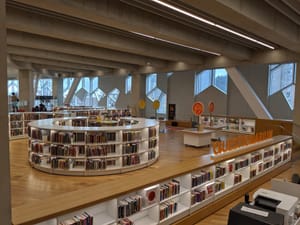I find it convenient to think about current library systems activities in terms of support for three materials workflows: bought/print materials, licensed/electronic materials, and digital/digitized materials. This is being pragmatic rather than pure, and is open to challenge on many grounds. I have discussed these at more length here, and suggested some ways in which they are developing. Development is in two directions: each of the areas continues to develop itself, while at the same time there is a growing desire to find better ways of working across them (e.g. at the discovery layer, or in terms of a more unified approach to metadata creation/management).
Now, we have an agreed and well-understood set of processes around the first category. These are encapsulated in the integrated library system, and still quite strongly influence library organization. These include things like selection, acquisition, cataloging, circulation, catalog, and so on.
We have a less well agreed set of processes around the second area, and an emerging apparatus of systems support. This includes resolvers, ERM systems, A to Z lists, metasearch, and so on. A level of agreement is apparent in that substitutable systems are now available to support this activity. However, differences in organizational structure to support the area and low takeup of ERM systems suggest that we are in early days. One place where there is likely to be further evolution relates to the creation, management and sharing of the data used to drive these systems.
And we have a much less well agreed set of processes around the third area. Libraries are exploring repositories for digitized collections, they are creating institutional repositories, and building workflows for content preparation and ingest, metadata creation, and so on. In fact, there is no agreed level of service in this area: you do not naturally expect to find particular services here in the way, for example, that you expect to find a circulation system. Of course, this lack of agreement makes this a potentially expensive area. There is a lot of figuring out what to do, and routine off-the-shelf tools or services may not necessarily exist across the range of what you want to do.
This is an overly complex systems landscape, and it will have to be rationalized in coming years so that libraries can spend more time putting their systems to work in support of their users and less time actually getting their systems to work together at all.
Anyway, this is by way of prelude to an observation about repositories. A couple of repository launches have come over my horizon in recent weeks.
The first is the Digital Conservancy at the University of Minnesota, which I mentioned the other day. This aims to provide services in relation to two classes of material: faculty research outputs and university administrative materials that traditionally would have gone to the University Archives. As I suggest in my post this makes a lot of sense: the repository aims to support the full range of institutionally produced intellectual outputs.
The second was the Open University’s Open Research Online, “a repository of our research publications and other research outputs.” In this case, the service aims to provide support for all the research outputs of OU academics. So, what you will find are deposited open access materials. However, you will also find citations to books, journal articles, and so on, which are not actually available in the repository: you may be referred to a publisher site. The repository aims to provide a full record to research activity, not only the open access materials.
What we have here, then, are well-worked through services which offer overlapping but different views onto their University’s intellectual outputs. This is not a major issue as universities work towards a view of what should be offered and what their constituencies value.
However, in the longer term, lack of agreement about services and supporting processes may be a barrier, on the management side where different systems support is needed, or on the user side where different services from different universities may lead to confusion, reducing the gravitational pull that familiarity supports.
Aside: Of course, in the longer run also, there are interesting questions about the relationship between these institutional services and network level services but that is a discussion for another day.
Related entries:
Share
More from LorcanDempsey.net



